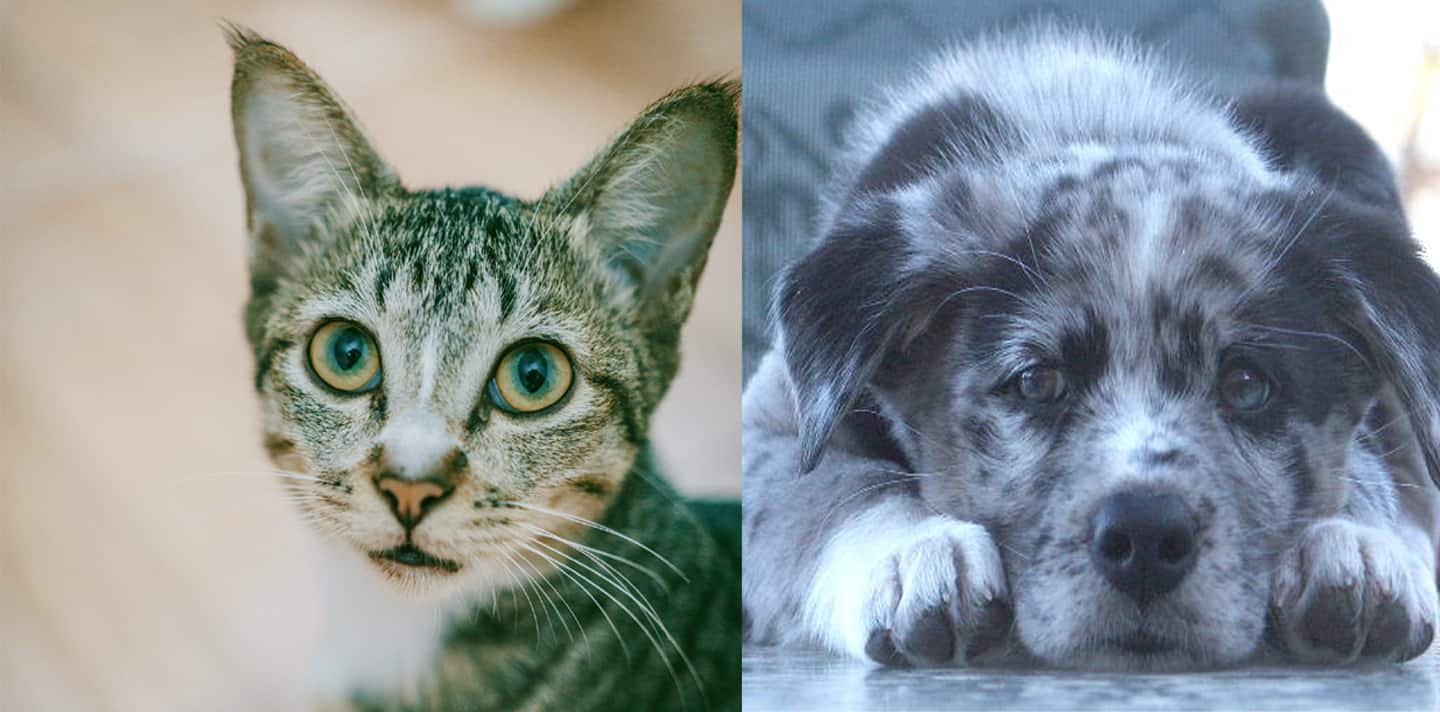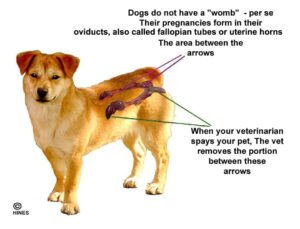At What Age Should I Spay or Neuter My Puppy or Kitten? When to spay or neuter your dog or cat.
Ron Hines DVM PhD
Every year more studies appear that confirm that neutering juvenile pets is a bad idea.
 Another Side Effect Of Early-age Neutering?
Another Side Effect Of Early-age Neutering?
I have been surgically altering dogs and cats for many many years. Over the years, my thoughts on this subject have changed. During most of my career, it was a given that all pets should be neutered. We accepted that without question. Most veterinarians still do. But with time, I began to realize that many of the reasons given for this surgery were not based on science or the long-term welfare of individual, beloved pets. Years of observing pets in my practice led me to realize that many of the problems I was treating could be traced back to the pets being surgically neutered or neutered too young.
Why Do Veterinarians Spay Female Pets And Neuter The Males?
In rural communities, veterinarians did not frequently spay dogs and cats until the late 1940s. But in urban settings, owners found the heat cycles of their female pets and the puppies and kittens that resulted were a major inconvenience.
When pentobarbital sodium anesthetic became available in 1930, it made veterinarians more confident about entering the abdomen of dogs and cats to perform serious surgery. Soon, at owner’s requests, it became common for them to remove the pet’s ovaries and uterus to prevent heat cycles, puppies and kittens. But it was not until the rise of the humane movement in the 1950s that public interest focused on spaying female dogs and cats and neutering male pets as a mater of “civic duty”. This began in New York City in the late 1950s at the ASPCA hospital. Their staff saw sterilization as a solution for the ever-increasing problem of more adoptable pets than potential new pet owners. By 1964, they were offering free sterilization surgeries to financially hard-pressed owners. During this same period, humane groups throughout the United States began to incorporate polices that prohibited the adoption of un-neutered orphan animals. In 1975, the Maryland SPCA began performing spay-neuter surgery on immature kittens and puppies. This was to comply with their bylaw changes that required that all adoptable pets – regardless of age – be neutered. I was their veterinarian at the time. In 1981, I worked with Amy Freeman Lee to set up a similar program in San Antonio, Texas. Faced with the grim task of euthanizing unwanted pets, I hope you can see how kind, well-meaning people might pursue such a policy. We were inundated with puppies and kittens, many of which were the result of accidental breeding of young adult animals on their first heat cycle. Our understandable thought was: “if every dog was neutered before it could give birth, we wouldn’t have to deal with the sadness of so many homeless strays”. Shelters across the US began to employ full-time veterinarians to do these early spays; these veterinarians organized a Society, founded a journal that would accept their publications, and became a potent force in the veterinary community. By 1993, the AVMA had also given its blessing to early spay/neuter. Few veterinarians in private practice questioned these policies. In the American Veterinary Medical Association, non-practicing veterinarians have a disproportionately large influence on policy decisions. These decisions eventually influence everything from State and Federal law to widely held public conceptions and misconceptions. Veterinarians in private practice are fragmented. We do not have the time or resources to attend the many conventions and symposia at which these policy decisions are made, and many veterinarians would find these conventions dry and tedious – like a day watching CSPAN. But there was another important factor – many veterinarians preferred neutering immature pets. There are a number of good, practical reasons for this:
1) The reproductive tract of juvenile pets is less vascular. That is, it is less likely to undergo excessive bleeding. In younger pets, no internal sutures are needed at all.
2) Juvenile pets are less obese. Abdominal fat complicates the surgery and the suturing process.
3) Juvenile pets heal very rapidly. Within 5 days of surgery, their spay incision is hardly noticeable.
4) Neutering pets young avoids the complication of owners bringing their female pets in when they are in heat or already pregnant. Bitches in heat bleed excessively during surgery.
5) Juvenile pets are smaller, easier to handle and less exhaustive of supplies and labor. One tires after a day of hoisting 60 lb dogs onto the operating table. At that time, veterinarians knew very little of the negative implications of juvenile neutering and thought “if we neutered pets young, so much the better for everybody”.
But Did Any Of These Reasons Address The Long-term Health Of My Pet?
Yes. Some did.
Through observation, veterinarians knew that spayed female dogs were less likely to develop breast tumors later in life. Spayed pets were also prevented from developing uterine tube infections (Pyometra) because their reproductive tract had been removed. They also knew that unsupervised neutered male dogs and cats were less likely to roam and that neutered male cats were much less likely to spray urine around the house or get into cat fights. However, they were working with a primitive understanding of the complexity of the endocrine system, how it works and what depriving a puppy or kitten of its ovaries or testes would also do. Unfortunately, the age at which your puppy or kitten had these procedures performed was not considered.
Are There Negative Health Effects of Spay/Neuter?
Yes. There are many. I will get to them later.
Do The Negative Effects Outweigh The Positive Effects Or Vice Versa?
No one can answer that question for you. It depends on your value system. Is your personal dog or cat’s long-term health your primary concern? Or is the dog and cat overpopulation your primary concern? It is popular today to make blanket, all-inclusive statements on what decisions are right or wrong. But that is a foolish approach – at least when it comes to neutering your pet. What you should do is consider the facts. There is plenty of information out there, and you don’t need to be a scientist or a veterinarian to understand it. If you read on, I will present you with most of that information as we understand it.
What Are The Benefits Of Spaying or Neutering My Pet?
Less Mammary Gland Tumors
Veterinarians know that the breast lumps we see in older female dogs occur most commonly in the pets that have not been spayed, or the ones that were spayed after they had had more than two heat periods. During heat (estrus), certain hormone levels in your pet spike. The more spikes or heat cycles your dog experiences, the more likely these tumors are to occur. That said, the risks are not high. One study found that the lifetime risk of mammary gland tumors eventually causing the death of a dog was only ~ 6% (6 deaths per 10,000 dog years). In contrast, the risk of a 45-year-old woman developing cardiovascular disease is 55.6%. The most common ones in dogs are mixed mammary tumors. These hard nodules and lumps tend to grow slowly as the pet ages. Although some of them have the potential to become malignant and life-threatening, the majority never do. Most are quite easy for your veterinarian to successfully remove. Mammary gland tumors are rarer in female cats. As in dogs, spaying reduces their frequency. But unlike dog, when they do occur in cats they are considerably more serious and need immediate veterinary attention.
No Pyometra
Pyometra is a condition where pus forms in your pet’s womb due to repeated hormonal over-stimulation of your female pet’s reproductive tract. Estimates of the incidence of Pyometra in older, unspayed, female dogs range from 1-15%. When it occurs, it can be treated successful by surgically removing the womb. When a female dog or cat is surgically neutered with traditional methods at any age, Pyometra will not occur. Since your female pet’s womb (fallopian tubes and uterine body) only secrete nutrient-rich fluids under stimulation from its ovaries, Pyometra is also quite unlikely to occur if surgical methods that only remove the ovaries are used.
No Estrus Mess
Most Unspayed female dogs are messy during the early part of their heat cycles (proestrus). This occurs every 5-10 months and last 6-11 days. During their estrus period, female dogs often urinate more frequently, lick their genitals, drip bloody fluids and crave attention. Their presence will attract the stubborn amorous attention of un-neutered male dogs running loose in your neighborhood. Unspayed female cats cycle more frequently. During their estrus cycle they become more demanding of attention, with frequent rubbing, purring, rolling and meowing. It is not normal for them to bleed. These periods last 4-10 days.
No Humping Dogs
Many of my clients are embarrassed when they find their male dog mounting another dog – or them. Unspayed female dogs occasionally do this as well. Neutering male dogs usually ends this behavior. Male dogs are very persistent in getting to female dogs that are in heat. If a loose female dog in heat passes your yard, it is not uncommon for your pet to dig out or escape to join it.
Less Wandering
Loose, neutered dogs tend to stay closer to home and get into less trouble around the neighborhood. The same goes for neutered cats. If you let your pets run loose and unattended, they will live longer before they are killed by cars than they would have if you had not neutered them. But why are your pets out-and-about unattended?
Less Aggression
Dogs with problem aggression tend to gain weight and become more phlegmatic, and calm when they are neutered. However, because aggression has many causes, neutering does not always end the problem.
No Urine Spray
Un-neutered male cats and female cats fighting for territory tend to spray urine. This behavior usually ceases in male cats once they have been neutered.
No Testicular Cancer
The rate of development of testicular tumors in sexually intact old dogs is said by some to be about 7% (I have never seen a case). That means that of 100 un-neutered male dogs, at the most 7 might develop these tumors. Should such a tumor occur in an older pet, it is a simple operation to remove it. Dogs whose testicle(s) do not descend correctly from within their abdomens (cryptorchidism) have a considerably higher rate of a particular testicular tumor later in life. In those dogs, the solution is to neuter them or just remove the affected testicle once they are mature – not as puppies. Testicular tumors are even rarer in cats.
Less Prostate Disorders
Prostate cancer is quite rare in dogs and cats. But prostate enlargement is a normal sign of aging in un-neutered male dogs – as it is in men. In male dogs, prostate enlargement is sometimes associated with problems defecating. It rarely ever causes the urinary problems seen in men. Neutering your male dog removes the hormones that are though to be responsible for this condition. This can be done when, and if, a problem arises in your pet. There are alternative drug therapies that are sometimes more effective than surgery. Adding more fiber to your dog’s diet is often all that is needed. It is not a commonly recognized problem in cats.
Fewer Tumors Surrounding Your Pet’s Anus
These tumors are called perianal adenomas and adenocarcinomas. They occasionally occur in old, un-neutered male dogs. Eighty percent of these tumors are benign. They are the third most common tumor in old male dogs, and they occasionally occur in females as well. The benign form occurs less commonly in neutered male dogs. But studies indicate that the number of the more dangerous adenocarcinomas formed is not decreased by neutering. Any that are still under the control of sex hormones should respond equally well to GnRH medications. They are not a recognized problem in cats.
I Am Helping To Solve The Pet Over-population Problem
This is definitely true. If you are an irresponsible pet owner who lets your pets run loose in the neighborhood, this is a legitimate benefit of neutering. This is also an excellent way to make a “social statement” about your concern for animals in general. It is only better behavior on the part of American pet owners that will solve the homeless pet problem. In Sweden, for example, there are virtually no homeless dogs; yet only 7% of female dogs there are spayed – They are just more responsible pet owners than we are.
What Is The Negative Scientific Information About Spay/Neuter?
Back To The Pet Overpopulation-Pet Neuter Fallacy
Although it is true that neutered pets cannot breed, the pets that contribute to the pet over-population problem are not the ones owned by responsible people who have their pets spayed and neutered. It is not the fact that a pet is un-neutered that causes pet over-population any more than dogs having teeth is the cause of human dog bites. Owner education and stiff fines for people whose pets run at large are much more effective in controlling pet over-population than surgical procedures.
Your Pet Will Miss Out On The “Miracle Of Birth”
I have clients that are concerned that their dog or cat will miss out on the gratification of childbirth. Many tell me they want their pet to have “just one litter” before they have it neutered. This goes for owners of male pets as well who think their pet should sire at least one litter. The emotional needs of pets are not the same as the emotional needs of people. We think differently. There is no credible evidence that pets miss having litters or romantic liaisons. What is important to them is your love.
Distorted Bone Structure
Distortion of your pet’s body by early age neutering contributes to a number of diseases – some of which I cover below. As your pet matures, hormones produced by its testes and ovaries determine the shape and length of its bones. When these hormones are removed too soon through neutering before puberty, the bones grow for a longer period and to different proportions. This results in your pet becoming taller with abnormally shaped bones. This change in bone conformation means that angles and forces between bones and ligaments are changed from their natural design and could be more likely to fail. Your dog’s knees are particularly at risk. This phenomenon has not been studied extensively in dogs, but it has in immature livestock and in children. The same situation has been confirmed in cats neutered at an early age.
Osteosarcoma (Bone Cancer)
We see these bone tumors most frequently in large and giant breeds of dogs that are already predisposed to them through their excessive bone growth. Spay-neuter before one year of age significantly increases the development of these tumors. The problem is very rare in cats and there is no data as to any effect spay/neuter might have on them.
Hypothyroidism
Hypothyroidism is a much more common disease in dogs than cats. Neutered dogs are at a significantly higher risk of developing this condition than those that are not. Read about hypothyroidism in dogs here.
Weakened Ligaments, Orthopedic Disorders And Subsequent Arthritis
It is difficult to decide when torn cruciate ligaments, hip problems and arthritis occur due to the obesity that often accompanies neutering or when it is due to a decrease in joint strength and altered structure that also accompanies neutering. The inactivity of many neutered pets may also contribute to this. Whatever the cause, veterinarians and others have noticed that all these problems increase in frequency in neutered pets.
Hip Dysplasia
Some dogs that are neutered young are prone to develop hip dysplasia. However, there are many factors responsible for the development of hip dysplasia and spay/neuter is probably not a major one. Read about hip dysplasia here.
Obesity
Neutered and spayed pets tend to get fatter than those that remain intact. There is no denying this. That risk is increased when they are neutered before their first heat cycle. There is also no denying that limiting your pet’s food intake will prevent this. But that is considerably easier said than done. When they do become too chubby, they suffer an increased risk for all the problems that overweight humans face. In cats, that includes diabetes, inflammatory bowel disease, gall bladder and bile duct problems arthritis and hepatic lipidosis. Read about obesity in pets here.
Cruciate Ligament tears
Spayed and neutered dogs have a significantly higher incidence of this disease. Read about cruciate ligament tears here.
Urinary Tract Problems
Veterinarians have noticed that it is spayed, overweight, female dogs that suffer the most urinary tract infections. Whether this is due to their obesity that causes vulvar inflammations or the urinary incontinence of low post-spay estrogen levels is unknown. When these female pets were neutered too young, some required later surgery to repair their poorly developed vulvas. Read about that problem here. This does not appear to be a significant problem in neutered male dogs or in neutered female cats. There has been speculation, over the years, that early neutering of male cats leads to urethral blockages (FUS). Most cats that develop blockages are neutered males – but then almost all our male pet cats are neutered. This problem and the next two, are more likely to occur when early spay prevents the normal development of the vagina and labia. Read about one urinary tract problem in cats here.
Urinary Incontinence
This is primarily a problem in spayed female dogs. Many of these dogs get better when given female hormone – the ones no longer present after spay.
Urinary Tract Infections
These too are more common in spayed female dogs. But these dogs tend to be overweight which may account for their increased risk.
Diabetes
Neutered pets tend to get fat. And in fat cats, diabetes risk increases dramatically. The situation is not as clear in dogs. The relationship between missing sex hormones, diabetes, obesity, and bone strength is more studied in humans. There is no reason to assume it would differ significantly in our dogs and cats. Read about diabetes in dogs here. In cats here.
Hemangiosarcomas
This form of cancer is most common in dogs. Statistically, it occurs considerably more frequently in pets that are neutered.
Earlier Mental Decline
Do Veterinarians Disagree On This?
Yes.
There is considerable disagreement. That is because there are so many powerful organizations with conflicting goals and philosophies exerting their influence on public opinion. Your local veterinarian is just a tiny cog in this great debate. His or her personal opinion and yours has little influence when up against well-funded national groups like HSUS, ASPCA, AVMA, animal shelter vets and profit-driven corporate animal hospital chains – all intent on shaping debate and self-protection. Those groups lobby heavily at your local, state and national level for misguided, simplistic ordinances and laws that will supposedly solve the ownerless pet problem. None but a few hasty folks in these organizations really believe that; but it is very effective in fattening organizational pocketbooks. Your dog and cat have no one lobbying in Washington, your capital or at your city council for their long-term health interest.
What About The Diseases that early Spay/Neuter Advocates Bring Up As Reasons For Me To Neuter My Pet?
All lives come to an end one day. It is true that spay /neuter lowers the risk of your pet suffering from certain specific and quite uncommon problems – but there is no credible evidence that neutered pets live any longer than un-neutered pets. Actually, the overwhelming evidence is just the opposite. There are many legitimate reasons for neutering cats and dogs – but living longer, healthier lives is not one of them. Spay and neuter is less common in Europe. European pets do not live shorter lives. They also have less homeless dogs and cats. That is because Europeans and UK citizens are culturally less likely to allow their pets out-of-doors unattended. Despite this, advocates of early spay/neuter tell pet owners that their pets will live longer and that there will be less homeless pets if their pets are neutered. Studies indicate the opposite is true. In a 2009 study, un-neutered female rottweilers lived an average of 30% longer than a similar number of rottweilers spayed in their first 4 years of life. This mirrors the results of a study in nurses in which lifetime decreased significantly when, as patients, they had their ovaries removed before the age of 50. Despite years of one-sided early spay/neuter propaganda, I believe that there are no fewer homeless pets in the United States today than there were 20-30 years ago.
If Early Neutering Is Such A Bad Idea, Why Is It Being Encouraged So Much?
The American Spay/Neuter Coalition:
As I mentioned, there are a group of powerful organizations that promote pediatric spay/neuter for a variety of reasons. A few of those reasons are admirable – if naive. Many are neither admirable nor naive. They are all skillful fund-raisers, they control the national narrative, and they compete for your donation dollars. They push whatever buttons and display whatever photographs bring in the most revenue. None of them are knowledgeable in reproductive endocrinology, population dynamics, the motivations of human behavior or your dog and cat’s long-term health interests. Their doctrine is rigid – no one is allowed to march out of step. I doubt that they have some diabolical plan – it is just a tacit alliance of powerful groups driven by mutual self-interest and shared short-sighted agendas.
The American Society For the Prevention Of Cruelty To Animals (ASPCA)
This is a forceful group of individuals devoted to “animal welfare” as they define it. On the subject of spay-neuter, their policies strongly encourage pediatric spay/neuter surgery. According to online information, their 2016 revenues were $191 million dollars and their CEO’s salary $538,057 (including a $100,000 bonus).
The American Veterinary Medical Association (AVMA)
Your pet and pet owner interests are near the bottom of AVMA priorities. The AVMA is a union, no better or worse than any union. It looks out for its member’s interests. It’s reported 2022 revenues were $48,376,453. That money is primarily derived from special interest groups, convention exhibitor fees, and drug company advertisements appearing in their journals. There is little to no transparency as to the financial drivers of policy decisions. Through the AVMA’s Animal “Welfare” Committee, they make recommendations – such as the AVMA Guidelines on spay/neuter that gloss over the vast negative findings of research published in their own journal. To the best of my knowledge, none of their 16-member Animal Welfare Committee represents the long-term health interests of your dog or cat. There are many competing interests and tensions within the AVMA – all revolving around power and money. Being a life-member, I am quite ashamed that in their 155 years of existence they have never funded a single study or organized a single symposium to examine, confirm or disprove the negative health issues associated with pediatric age spay/neuter. They have never encouraged alternative, less dangerous, ways we veterinarians might address the pet overpopulation problem. True to form, on July 14, 2023, seeing the potential of lost veterinarian revenues, the AVMA began to “vigorously” lobby against dog and cat rescue centers being allowed to have competent veterinary nurses (Licensed Veterinary Technicians/LVTs & Certified Veterinary Assistant/CVAs) neuter homeless dogs and cats. A blow to pet rescues operating on a shoestring. They euphemistically title their proposed federal and state bill the “Safeguarding Care For Animals with Veterinarian-Led Teams” aka No veterinary Nurse Practitioners allowed to spay pets, homeless or not. (JAVMA,261(9)1285). In 2023, to protect veterinarian’s revenues, they are vigorously lobbying against California legislature’s Assembly Bill 1399 regarding telemedicine. All humane societies support it. The bill passed the State Assembly 76-0 in 2023 and, as of this writing, awaits Governor Newsome’s potential signature. He has until Oct. 14. The AVMA will not lose gracefully. According to OpenSecrets, the AVMA spent close to 1.2 million dollars in 2022 on its Washington lobbying efforts. How much they spent on lobbying at the state level is not reveled. Their executive compensation in 2020, according to ProPublica is $3,539,801. Base+Other compensation of their Vice President was $423,367. The salary of their chief governmental relations officer was $350,318. The salary of their chief lobbyist in Washington in 2023 was $207,687. The AVMA is known for its top-level employee largess, three times the number of high earners than the AMA.
The HSUS
The Humane Society Of The United States. This competitor to the ASPCA had net assets in 2017 of $319,000,000. They are an active promoter of early age spay neuter and mention nothing about the negative aspects of this procedure on your pet’s health.
PETA
With 2017 donation revenues of $46,349,951, gross merchandise sales of $491,974, and dividends, interest and royalties, of $1,626,587, PETA is a small, but very vocal advocate of early spay/neuter. They drive a bus around that performs the procedure. In one of their online 2013 articles, that promoted neutering your pet “soon after the age of 8 weeks” stating that some shelters recommend doing it even earlier as being “less stressful for animals”.
Winn Foundation
This organization was founded by the Cat Fancier’s Organization in 1968 to improve the health of cats. Under its current leadership, it has transformed its mission to become a strong lobby for the spay/neuter of infant (“prepubescent sterilization”) cats. It does not make its IRS 990 available online to the public.
The Corporate Animal Health Care Industry
There was a time when veterinarians were responsible for setting policy within the veterinary practices that they owned. That is becoming less and less the case. More and more of your veterinarian’s decisions are being made by publicly traded companies that operate to maximize revenues. Neutering pets at any age is a source of revenue. (see here) But treating the many diseases that early age sterilization encourages is where the big money lies. That treatment is expensive, there are no cures, so you have the client for life. To a shareholder, a CEO or a corporate accountant, current pediatric spay/neuter policies make perfect sense.
VCA Antech Inc.
Veterinary Corporation Of America was founded in 1986 by three MBAs from the human health care industry. Their 2016 revenues were 2.52 billion dollars. Their website brochure, as of this writing, makes no mention of the negative aspects of early spay/neuter. It downplays them or declares them false and sees no problem with pediatric spay and neuter.
Banfield Pet Hospitals/PetSmart
Banfield Pet Hospitals, located in PetSmart stores, had 2017 revenues of 774.4 million dollars. They were recently purchased by the Mars Candy Company which now owns both VCA and Banfield. Banfield’s spay/neuter webpage makes no mention of the negative health aspects of early age spay/neuter. Their puppy health webpage states that although many veterinarians recommend dogs be spayed or neutered at 6 months of age, “Having the procedure done sooner can benefit your new puppy in a number of ways”.
The AVMA
On July 14, 2023, seeing the potential of lost veterinarian revenues, the AVMA began to “vigorously” lobby against dog and cat rescue centers being allowed to have competent veterinary nurses (Licensed Veterinary Technicians/LVTs & Certified Veterinary Assistant/CVAs) neuter homeless dogs and cats. Humane societies operate on a shoestring. That AVMA decision will greatly increases the number of dogs and cats euthanized at animal shelters across America. They euphemistically bill their nationwide lobbying effort” Safeguarding Care For Animals with Veterinarian-Led Teams” aka No veterinary Nurse Practitioners allowed. (JAVMA,261(9)1285)
If I Decide To Have My Pet Neutered, What Can I Do To Minimize Risks?
I am not against neutering pets at the right time and for the right reasons. If you have a kitten, or puppy, do not rush to have it “fixed”. Confining your pet to your home as a teenager is quite sufficient. I could not live with my 4-year-old male cat, Oreo, if he had not been neutered. But wait until cats are sexually mature to have them spayed and neutered. The time cats become sexually mature and the time their adult canine teeth (fangs) reach their full length generally coincide. Decisions based on hormonal analysis of the blood of your pet might be more scientific, but I have observed through many years of practice that examination of the canine teeth is quite accurate and effective. If you have a female cat, you must be very careful not to let it escape outside during its first heat, or it will most certainly become pregnant. It can be spayed during its heat period or shortly thereafter. If you have a male cat and let it roam before it is neutered, it will fight; develop bite infections and possibly incurable feline AIDS or Feline Leukemia. Once it is neutered, still do not let it out of doors unleashed or unaccompanied.
If you have a female dog or puppy, wait until 3-6 months after its first heat period to have it spayed. Time the surgery before its anticipated second heat period. If you have a female dog, let it pass through one heat cycle before considering having it spayed. The hormone symphony that accompanies heat affects all of your pet’s body, not just its reproductive tract. This is something that proponents of early spay/neuter do not understand. If you have a male dog, consider if you really need to have this surgery performed. My Labrador, Max, is not neutered. He is the proud father of zero puppies and will stay that way. Mounting family members is a normal rite of passage and a sign of approaching puberty in puppies and adolescent dogs. If normal adolescent mounting behavior embarrasses you – remember it will pass, given a little patience and some instruction. It is important for your pet’s long-term health that these hormones flow in its body for at least a while.
If you decide you must neuter your male dog, do not do it until well into their second year. If your pet has medical or serious temperament problems that might benefit from an earlier neuter, you might consider it a bit earlier. But there are often non-surgical ways to tackle the problem – try them first. Some owners have their male dogs neutered only to find that the problem for which it was done did not go away. If you are uncertain, have your pet receive a reversible sex hormone blocking injection first. If it has no effect on the problem, removing its testicles will not either.
Neutering pets at an older age necessitates keeping them trim. Fat pets are harder for veterinarians to work on, and blood vessels become harder to identify and tie off securely. Dogs and cats will eat to please you if you over feed them. There is a long list of health reasons not to do that.
How Long Will The Practice Of Early-Age Spay/Neuter Continue?
That will depend on the efforts of pet owners like you. I am confident that there will come a time when pediatric spay/neuter of our pets is considered to have been a major error in judgment.
Organized institutional pressure to practice pediatric spay/neuter is very pervasive in America. Its proponents are highly vocal and well financed. No level of government is free of their mantra. Their many publications are carefully sanitized to assure only their side of the question is presented.
These corporate and institutional interests promoting early spay/neuter have similarities to another large American corporate interest. Both had stakeholders at many levels in the Community. Both were well-funded and sophisticated. Both were motivated by money and both had negative health effects on the creatures that consumed their “product”. Both were willing to exert pressure on the government and others to preserve their livelihoods. Both fund large advertising campaigns to manipulate public opinion and both fund research likely to be favorable to their cause.
The negative health implications and dangers of smoking first appeared in scientific publications in the 1950s. It was not until 1963 that per capita cigarette consumption in the US dropped and not until 1998 that their trade and lobbying group, the Tobacco Institute, was dissolved. Negative information on the dangerous side effects of early age spay/neuter first appeared in scientific publications in the early 70s and continues through today. At what age that you spay or neuter your puppy or kitten makes a difference for the rest of its life.
Bad habits die hard, but these are just my suggestions as to what age you should spay or neuter your puppy or kitten.

There might be some alternatives in the future. In 2023, several grants from the Michelson Prize Foundation regarding anti-müllerian hormone finally bore fruit. Researchers at the Massachusetts General Hospital and their collaborators at the Cincinnati Zoo demonstrated that a single injected dose of a gene therapy-based treatment induced long-term contraception in a group of female domestic cats. That might potentially provide a safe and effective alternative to surgical spaying while preserving the beneficial effects of sex-related hormones. (read here)
You are on the Vetspace animal health website
Visiting the products that you see displayed on this website help pay the cost of keeping these articles on the Internet.






